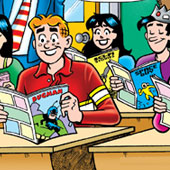- Arnold, Bruce. (2008). Comic, Anime and Postcard Censorship (http://www.caslon.com.au/censorshipguide14.htm)
- Coville, Jamie. (2011). 1954 Senate Subcommittee Transcripts.(http://www.thecomicbooks.com/1954senatetranscripts.html)
- Gardner, T. (2007). Getting Graphic.(http://www.thecomicbooks.com/1954senatetranscripts.html)
- Gray, W.S. (1942). Educational News and Editorial Comment. The Elementary School Journal. Vol. 42, No. 9, 641-655.
- McCloud, Scott. (1993). Understanding Comics: The Invisible Art. Kitchen Sink Press.
- National Council of Teachers of English. (2005).Using Comics and Graphic Novels in the Classroom.(http://www.ncte.org/magazine/archives/122031)
- Singh, V. (2009, October 16). Now, Amar Chitra Katha gets even younger. The Times of India (http://articles.timesofindia.indiatimes.com/2009-10-16/mumbai/28085525_1_amar-chitra-katha-ack-anant-pai)
- Sones, W.W.D. (1944). The Comics and Instructional Method. Journal of Educational Sociology. Vol.18, No.4, 232-240 (http://www.nytimes.com/2009/04/05/business/05stream.html)
- Stone, B. (2009, April 4). Is This the Future of the Digital Book? The New York Times.
- Versaci, R. (2001). How Comic Books Can Change the Way Our Students See Literature: One Teacher's Perspective. The English Journal, 91 (2), 61-67.
- Yang, G. (2003a). History of Comics in Education (http://www.humblecomics.com/comicsedu/history.html)
- Yang, G. (2003b). Strength of Comics in Education (http://www.humblecomics.com/comicsedu/strengths.html)
- Coville, Jamie. (2011). 1954 Senate Subcommittee Transcripts.(http://www.thecomicbooks.com/1954senatetranscripts.html)
- Gardner, T. (2007). Getting Graphic.(http://www.thecomicbooks.com/1954senatetranscripts.html)
- Gray, W.S. (1942). Educational News and Editorial Comment. The Elementary School Journal. Vol. 42, No. 9, 641-655.
- McCloud, Scott. (1993). Understanding Comics: The Invisible Art. Kitchen Sink Press.
- National Council of Teachers of English. (2005).Using Comics and Graphic Novels in the Classroom.(http://www.ncte.org/magazine/archives/122031)
- Singh, V. (2009, October 16). Now, Amar Chitra Katha gets even younger. The Times of India (http://articles.timesofindia.indiatimes.com/2009-10-16/mumbai/28085525_1_amar-chitra-katha-ack-anant-pai)
- Sones, W.W.D. (1944). The Comics and Instructional Method. Journal of Educational Sociology. Vol.18, No.4, 232-240 (http://www.nytimes.com/2009/04/05/business/05stream.html)
- Stone, B. (2009, April 4). Is This the Future of the Digital Book? The New York Times.
- Versaci, R. (2001). How Comic Books Can Change the Way Our Students See Literature: One Teacher's Perspective. The English Journal, 91 (2), 61-67.
- Yang, G. (2003a). History of Comics in Education (http://www.humblecomics.com/comicsedu/history.html)
- Yang, G. (2003b). Strength of Comics in Education (http://www.humblecomics.com/comicsedu/strengths.html)

